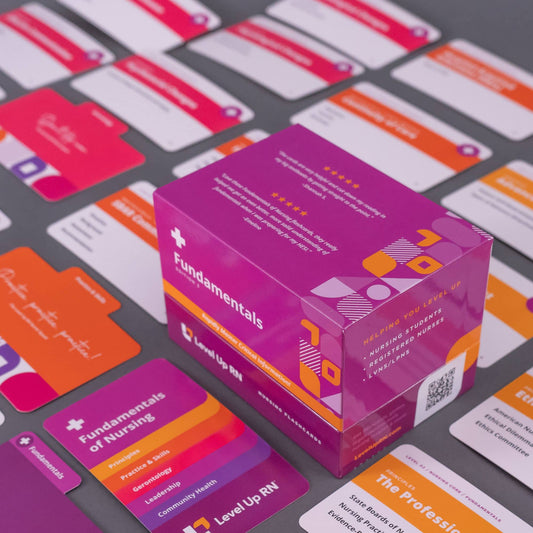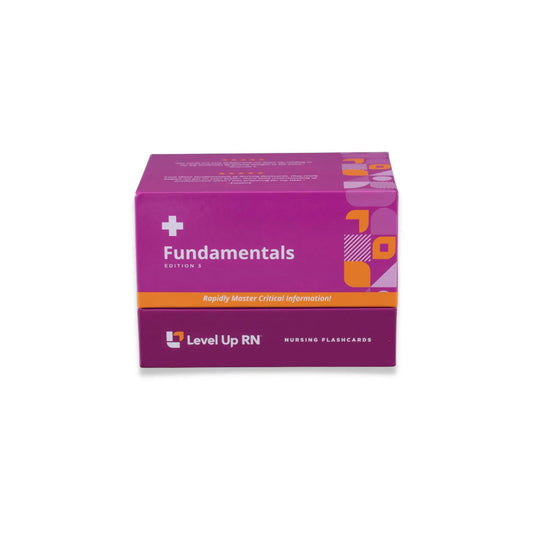This article covers wound care and diabetic foot care. You can follow along with our Fundamentals of Nursing flashcards, which are intended to help RN and PN nursing students study for nursing school exams, including the ATI, HESI, and NCLEX.
Wound care is an important aspect of nursing fundamentals. It’s also a speciality, with many established professional organizations set up in support of nurses who have earned their CWCN (and affiliated) certifications. If you've followed along with these videos, you might recall that Cathy Parkes is a certified wound care nurse. Check out our Wound Care Flashcards for Nurses for a deeper dive.
Wound Care
In the previous article in our series about skin integrity, we discussed various aspects of wound healing, including the phases of healing, intention, complications, barriers to healing, drainage, and appearance. There’s some overlap as we continue with a discussion of how to care for a wound, which deals more with the hands-on treatment of the patient.
Wound culture
When obtaining a culture of a wound, take the sample before beginning antibiotic treatment. The reason to obtain the culture before administering antibiotics is to avoid getting a false reading ― it is important to know how the healing process is progressing before administering antibiotics.
Make sure to irrigate the wound with normal saline. Do not use wound cleanser.
When swabbing, swab a 1 cm area of viable tissue in the wound bed for approximately 5 seconds, and use enough force to produce exudate (fluid that’s a byproduct of the white blood cells having killed bacteria, also known as pus).
Make sure to swab the wound for viable tissue; do not swab the eschar or slough (necrotic or avascular tissue — avascular tissue is tissue that does not contain blood vessels).
Also make sure not to swab the skin surface around the wound. This could taint the sample being obtained for the culture.
Irrigation
When irrigating a wound, wear a gown, gloves, and eye protection. This protects you should any liquid from an open wound splash back toward you.
Irrigate the wound with normal saline or a prescribed solution.
Use a 35-mL piston syringe and a 19-gauge catheter or needle to irrigate the wound, and use an irrigation force of approximately 8 – 15 psi (pounds per square inch); this administers enough solution without harming the patient. Irrigation is a cleaning process, with the goal of removing any sort of debris from out of the wound.
Sterile dressing change
Changing a sterile dressing is a skill that is part of any nursing fundamentals class. Follow these steps when changing a sterile dressing:
- When removing the existing dressing, use clean gloves to remove the soiled dressing, i.e., gloves off of the wall. Sterile gloves may not be required, depending on the type of wound.
- Note the appearance and drainage of the wound.
- Prepare a sterile field: perform hand hygiene, set up the sterile field, and don sterile gloves.
- Clean the wound with a gauze moistened with sterile saline or wound cleanser. Gently clean from top to bottom and/or from the center of the wound moving outward. Never clean toward the wound. The goal is to clean away from the wound to avoid introducing new bacteria. Use a new piece of gauze for each stroke.
- Consider the wound as a sterile environment (even though it is not) that requires protection — there is already bacteria in the wound, and the goal is to protect the wound from getting other, new bacteria dragged toward it.
- Once the wound is cleaned, remove the gloves, perform hand hygiene, and don new sterile gloves.
- Apply any prescribed topical medications and place a dry/sterile dressing over the wound. Secure the dressing with tape or a gauze wrap.
- Label the dressing with the date, time, and nurse’s initials.
Clean gloves versus sterile gloves
Clean gloves may be more appropriate for cleaning chronic or old wounds or pressure injuries. It is important to defer to the facility’s policy and guidelines regarding when it is okay to use clean gloves and not sterile gloves.
Removing sutures and staples
The following steps apply to the removal of sutures and staples:
- Before removing sutures or staples, make sure to have a provider order.
- Clean the incision before and after removal.
- As the staples and sutures are removed, count and chart the number that are removed.
- Remove alternate sutures and staples (that is, every other one). This is to assess for wound dehiscence (partial or total separation of previously approximated wound edges). If there is any dehiscence, leaving every other suture or staple in place will keep the wound in an easily closable state while the provider is contacted.
Removing sutures
To remove sutures, use a sterile suture removal kit (to avoid introducing new bacteria to the wound).
Grasp the knot of the suture with a pair of forceps and gently lift it. Then make a cut on one side of the suture below the knot, close to the skin, and pull the suture through the skin. This technique avoids pulling any dirty suture through the tissue that has already closed.
Removing staples
To remove staples, use a sterile staple remover.
Place the lower jaw of the staple remover under the center of the staple and squeeze the handles together. This has the effect of butterflying the staple, allowing it to come out easily.
Wound Drains
A drain is when tubing is inserted into a wound or cavity to remove blood and fluid. This promotes healing and reduces the risk of infection.
Types
A drain may be one of two types: open or closed.
Open drain
When the wound is draining freely, an open drain may be used, which utilizes tubing without a collection device. The fluid is deposited onto the surface of the skin or the dressing. A Penrose drain is an example of an open drain.
Closed drain
Closed drains are external tubing that ends in a container that uses negative pressure (i.e., suction) to collect fluid. Closed drains include the Jackson-Pratt (or JP) drain (a closed-suction medical device), hemovac drain (a device placed under the skin during surgery to remove any blood or other fluids), or anything that’s set to suction.
Care of a closed drain
When caring for closed drains, remember that they function using negative pressure, so it is important to secure the device to clothing to prevent pulling at the insertion site.
Empty a closed drain before it fills halfway. For a JP drain, which looks a little like a hand grenade, there is a little cap at the top, which can be popped open. Turn the container upside down and squeeze it to empty all of the contents into a graduated cylinder (to accurately measure the output). Before closing it, compress the container so that all of the air is squeezed out, and then replace the cap. That creates negative suction — the drain will attempt to reopen, constantly applying suction to the area where the drain has been placed in the body.
With the hemovac drain, compress it as if it were a hamburger and then close it. It, too, will try to open back up, creating the necessary negative pressure to work the drain.
Make sure to change the dressing daily. Clean the site around the drain using a new cotton swab for each swipe. And assess for signs or symptoms of infection (redness, purulent or odorous discharge, swelling).
Diabetic foot care
Diabetes is a chronic health condition that affects how the body turns food into energy. Diabetes causes chronic hyperglycemia (increased blood sugar levels) due to either insufficient insulin production by the pancreas or insulin resistance of the cells in the body.
Diabetes is one of the most common diseases in America, with one in ten Americans living with the condition, so you are likely to encounter many patients with some type of diabetes during your nursing career.
Learn more about diabetes, the endocrine system, and more with our Medical-Surgical Nursing Flashcards which are intended to help RN and PN nursing students study for nursing school exams, including the ATI, HESI, and NCLEX.
Foot care is very important for patients with diabetes because the feet of a diabetic patient can be injured easily. This means teaching the patient how to care for their feet to avoid injuries that could lead to serious complications, including amputation.
Diabetic foot care checklist
A patient with diabetes needs to see a podiatrist regularly and wear professionally fitted shoes. A professionally fitted shoe is crafted so the patient is not putting any undue pressure on their feet in a way that could cause blisters or injury.
Patients need to be taught to inspect their feet every day, using a mirror to help them. This can be done by placing a mirror on the floor, holding a foot over it, and looking at the foot. Then, pick the foot up and look in between the toes using the mirror. This is to catch any sort of skin breakdown as soon as possible. Also, patients should check the insides of their shoes for objects before putting them on.
Patients should apply moisturizer to their feet, but not in between their toes (where it will stay moist, which may cause skin breakdown).
Patients should wear cotton socks (no synthetic fabrics). They should not go barefoot or wear open-toe shoes.
When cutting their toenails, patients should cut straight across, and not round the edges. Use a nail file if necessary to file away any sharp corners.
Do not use any over-the-counter products to treat corns or calluses, which might lead to skin breakdown.
Patients should not use heating pads on their feet. This is because a diabetic patient may have neuropathy of their lower extremities and not feel the heat from the pad, even excessive heat, and this could lead to them burning their feet without their realizing it.
Finally, patients should not soak their feet. Prolonged moisture is not good for a diabetic’s feet. And when entering a tub or shower, the patient should check the water temperature with their elbow or wrist, not their feet — again, this is because if they cannot fully feel their feet, they may burn themselves on water that is too hot.



3 comments
Diabetics often have neuropathy; this causes them not to be able to feel the heat or the cold, therefore it can cause a thermal burn, and they wouldn’t be able to tell! :)
Diabetics should not use a heating pad because they can not feel it if it gets too hot, and can cause burns.
I was following all this discussion..thank you for taking sometime to make this topic easier to understand and to remember..👍